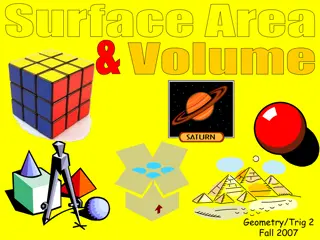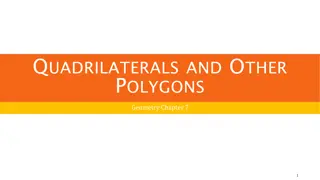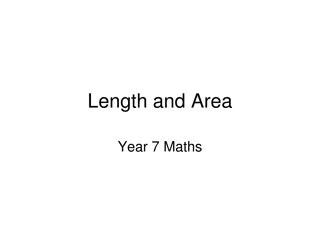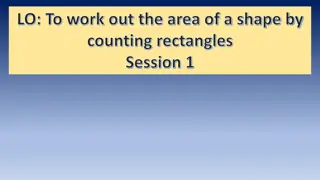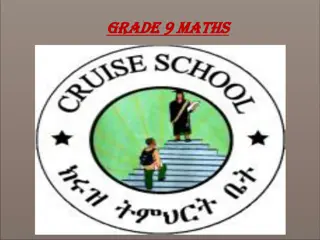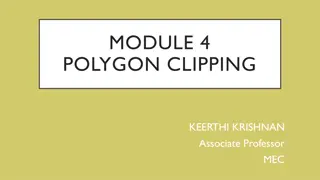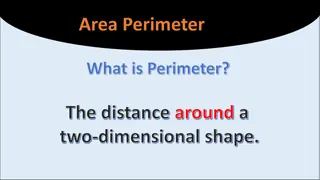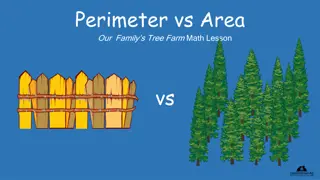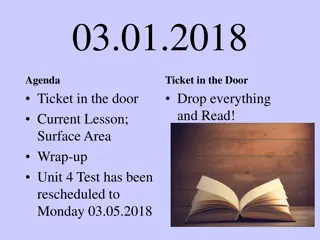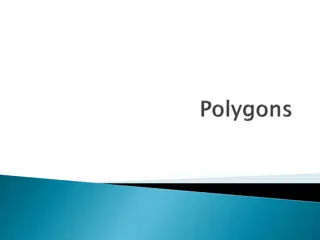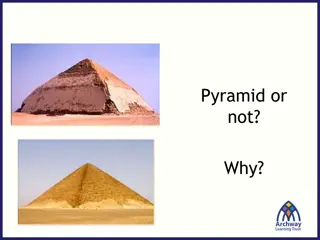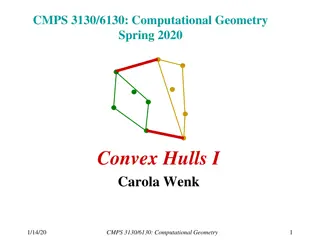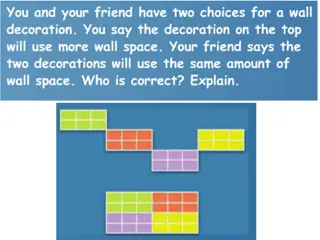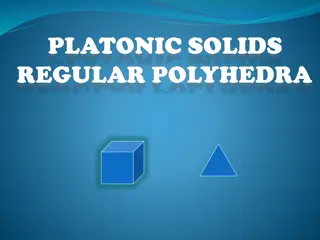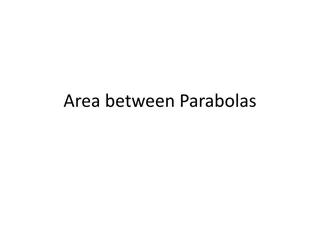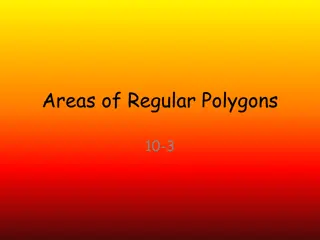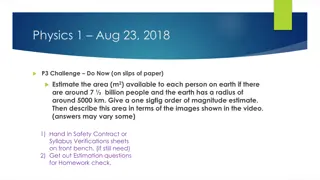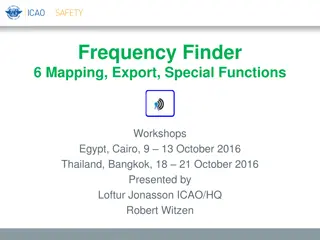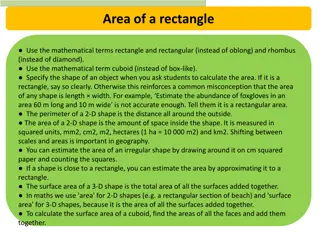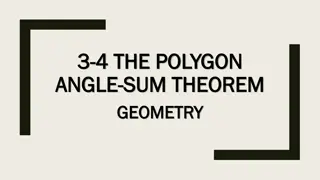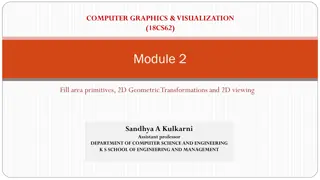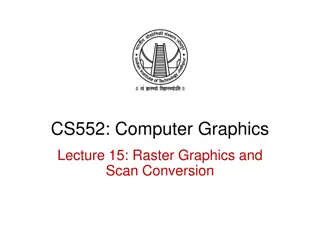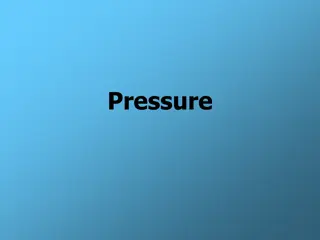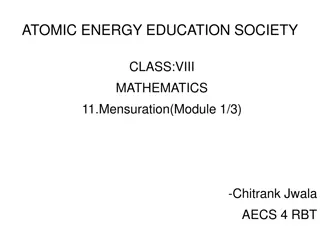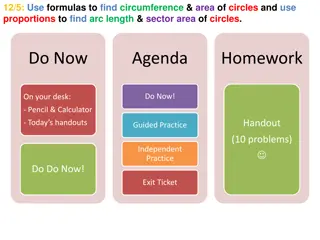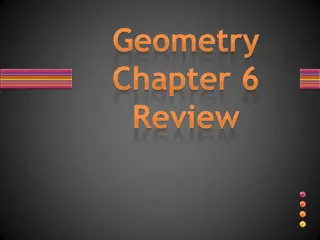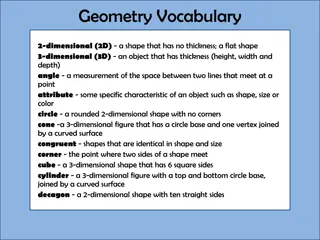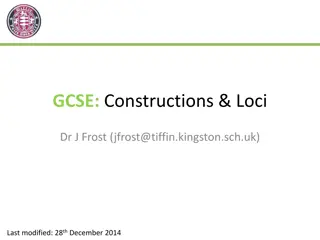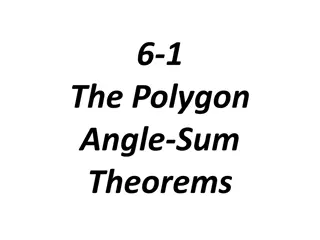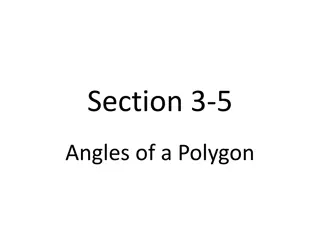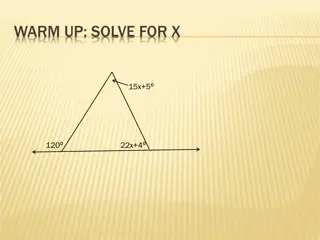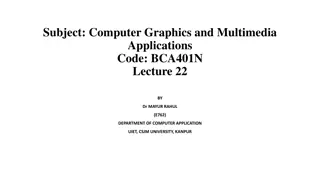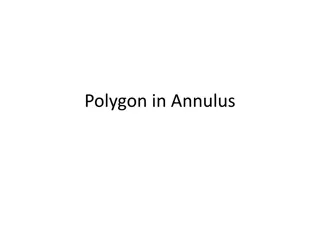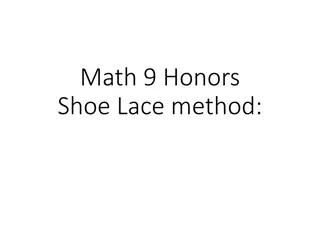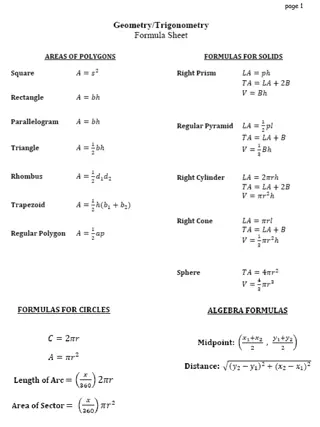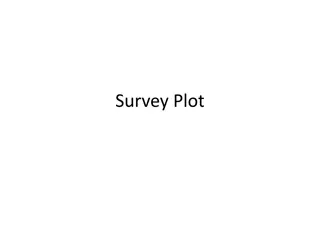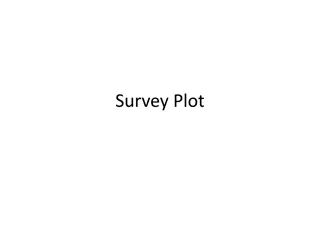Polygon Armchair | Occasional Chairs | Collective Melbourne
Buy Polygon Armchair allows you a complete custom transformation by selecting from Prostoria\u2019s wide range of fabrics, leathers & metal frame finish from Collective, Melbourne's premier luxury furniture makers. Visit Us Now!\n
1 views • 2 slides
Surface Area and Volume in Geometry
Gain insights into calculating surface area and volume of geometric shapes, specifically focusing on rectangular prisms. Learn how to find surface area and lateral area using formulas, and explore examples illustrating these calculations step by step with images.
2 views • 57 slides
Polygon Angles in Geometry
Explore the interior and exterior angle measures of polygons, understand theorems related to polygon angles, classify polygons based on their properties, and solve problems involving regular polygons in this geometry chapter slideshow. The content covers key concepts such as the sum of interior angl
1 views • 41 slides
Length and Area Concepts in Year 7 Maths
Delve into the world of measurements, accuracy limits, and area calculations in Year 7 Math. Learn about the accuracy of measurements, limits of accuracy, calculating the area of shapes, converting units of area, and investigating the area of triangles. Explore practical examples and understand the
0 views • 20 slides
Area of Shapes through Rectangles
This educational session focuses on learning to calculate the area of shapes by counting rectangles. It covers concepts of perimeter and area, providing visual examples and challenges to reinforce understanding. Students will engage in activities to practice determining the area of various shapes by
1 views • 35 slides
Discovering Geometry and Measurement Concepts in Grade 9 Mathematics
Explore the fundamentals of geometry and measurement in grade 9 math, covering topics such as regular polygons, congruence and similarity of triangles, construction of similar figures, trigonometric ratios application, circle properties, and problem-solving related to triangles and parallelograms. U
0 views • 17 slides
Polygon Clipping Techniques and Algorithms
Polygon clipping involves modifying line-clipping procedures to achieve bounded areas after clipping. The Sutherland-Hodgman algorithm is commonly used, where polygon boundaries are processed against window edges to generate closed areas for appropriate area fill. This process involves testing for v
1 views • 17 slides
Area and Perimeter in Geometry
Area and perimeter are important concepts in geometry. Area refers to the space inside a two-dimensional shape, while perimeter is the distance around the shape. Formulas and examples for calculating perimeter and area of rectangles and squares are provided in the content. Watch the linked videos fo
0 views • 13 slides
Perimeter and Area in Math
Explore the concepts of perimeter and area through simple explanations and visual examples. Learn how to calculate the perimeter and area of shapes like squares and rectangles with real-world applications in farming. Discover how farmers use perimeter to determine fence needs and area to plan tree p
1 views • 8 slides
Surface Area in Mathematics
Delve into the concept of surface area as an essential mathematical topic, understanding its significance in everyday life and its application in various 3D shapes. Learn how to calculate surface area for different space figures like prisms and pyramids through step-by-step methods. Engage with esse
6 views • 21 slides
Filling Polygons Using Scan Line Algorithm
Learn how to fill polygons using the Scan Line Algorithm, which involves intersecting scan lines with polygon edges and filling the area between intersections. Steps include finding Ymin and Ymax, intersecting scan lines with edges, sorting intersection points, and filling the interior of the polygo
0 views • 36 slides
Pyramid Geometry for Surface Area Calculations
Delve into the concept of surface area calculations for pyramids, ranging from identifying fake pyramids to determining the surface area of iconic structures like the Great Pyramid. Learn about the essential information needed, such as base length and slant height, to derive accurate measurements. D
0 views • 32 slides
Closest Pair and Convex Hull: Brute Force Approach
Closest Pair Problem in 2D involves finding the two closest points in a set by computing the distance between every pair of distinct points. The Convex Hull Problem determines the smallest convex polygon covering a set of points. Dr. Sasmita Kumari Nayak explains these concepts using a brute-force a
0 views • 15 slides
Convex Hulls in Computational Geometry
Convex hulls are a fundamental concept in computational geometry, representing the smallest convex shape that contains a set of points. The process involves defining the convexity of a set, determining the unique convex polygon, and computing the convex hull efficiently using algorithms. This conten
0 views • 9 slides
Geometry Concepts: Perimeter, Circumference, and Area
Explore the fundamental concepts of perimeter, circumference, and area in geometry through a series of problems and visuals. Understand how to calculate the perimeter of a rectangle, find the circumference of a circle, determine area in the coordinate plane, and solve for area of rectangular and irr
0 views • 13 slides
Regular Polyhedra and Polygons
Regular polygons and polyhedra are fundamental shapes in geometry. A regular polygon has sides and angles that are congruent, such as equilateral triangles and squares. Polygons are simple closed figures made with line segments. Polyhedra are solids bounded by polygons as faces. Regular polyhedra ar
0 views • 18 slides
Solving for Area Between Parabolas
Determine the bounded area between two parabolas by finding their intersection points and calculating the area enclosed. Follow a systematic approach independent of constants, consider translations to avoid negative areas, and evaluate the area accurately by tracking the curve shift. The mathematica
0 views • 32 slides
Areas of Regular Polygons
Explore the definitions, formulas, and theorems related to regular polygons, including central angles, apothems, and perimeter calculations. Learn how to find the area of a regular polygon through examples and solutions.
0 views • 11 slides
Estimating Available Area for Each Person on Earth
Consider estimating the area available per person on Earth based on a population of around 7 billion and the Earth's radius of approximately 5000 km using one significant figure. Relate this area to concepts discussed in the provided images, such as uncertainties in physics, accuracy, precision, and
0 views • 13 slides
Frequency Finder 6 Mapping Workshops Overview
Explore the Frequency Finder 6 Mapping, Export, and Special Functions workshops held in Egypt and Thailand in October 2016. The workshops cover topics such as mapping station coverage, exporting data to different formats, accessing historical frequency assignment records, and ensuring data integrity
0 views • 7 slides
Area and Surface Area in Mathematics
This informative content explains the concepts of area and surface area in mathematics. It emphasizes the distinction between rectangles, rectangular areas, cuboids, and rhombuses to promote accurate calculations. The importance of scale shifts, estimating irregular shapes, and calculating perimeter
0 views • 6 slides
Polygons in Geometry
Explore the concept of polygons, their sides, vertices, and angles, and learn to classify them as convex or concave. Discover the Polygon Angle Sum Theorem and find the sum of measures of angles in a given polygon.
0 views • 13 slides
Fill Area Primitives in Computer Graphics
An overview of fill area primitives in computer graphics, including the concept of fill areas, polygon fill areas, and polygon classifications into convex and concave polygons. This module covers the efficient processing of polygons, approximating curved surfaces, and generating wire-frame views of
0 views • 63 slides
Raster Graphics and Scan Conversion in Computer Graphics
This lecture covers various topics related to raster graphics and scan conversion in computer graphics. It includes issues with scan converting a line, generalized line drawing algorithms, and the midpoint circle drawing algorithm. Additionally, it explores deriving mathematical expressions for draw
0 views • 21 slides
The High Cost of Building in the Bay Area
Multiple factors such as land, materials, labor, fees, financing, consultants, and tax regulations contribute to the high cost of building in the Bay Area. Local policies, state priorities, federal regulations, and market forces also play a role. As a result, construction projects in the Bay Area ca
0 views • 6 slides
Pressure: Force, Area, and Application
Pressure is a fundamental concept in physics, defined as the force acting perpendicular to an object's surface area. This article explores what pressure is, how to calculate it, and provides examples of its application in everyday scenarios. Learn about the relationship between force and area, the f
0 views • 16 slides
Perimeter, Area, and Mensuration in Mathematics
In this educational module, we delve into the concepts of perimeter and area of closed plane figures like triangles, rectangles, circles, and quadrilaterals. We also discuss surface area and solve problems related to these geometric concepts. Through examples and visuals, students learn how to calcu
0 views • 11 slides
Circles: Formulas for Circumference, Area, and Proportions for Arc Length and Sector Area
Learn how to calculate the circumference and area of circles using formulas, and use proportions to find arc length and sector area. Master the concepts through examples and practical applications in geometry.
0 views • 18 slides
Geometry Chapter 6 Review Questions and Solutions
Explore a set of geometry review questions involving interior and exterior angles, polygon properties, parallelograms, trapezoids, and more. Test your knowledge and enhance your understanding of geometric concepts with these interactive problems.
0 views • 20 slides
Comprehensive Geometry Vocabulary Guide
This comprehensive geometry vocabulary guide covers essential terms related to 2-dimensional and 3-dimensional shapes, angles, attributes, and more. Explore definitions and examples of various geometric concepts like circle, cone, cube, cylinder, diagonal, hexagon, polygon, and more, accompanied by
0 views • 4 slides
GCSE Constructions and Loci Techniques
Explore a comprehensive guide to GCSE constructions and loci by Dr. J. Frost, covering topics such as triangle constructions, perpendicular bisectors, angle constructions, and polygon construction using basic tools like a straight edge and compass. Learn essential skills for precise geometric drawin
0 views • 35 slides
Polygon Angle-Sum Theorems
Explore the Polygon Angle-Sum Theorems that determine the sum of interior angle measures in polygons. Learn about the Polygon Angle-Sum Theorem, number of sides in polygons, finding angle sums, and the corollary for regular polygons. Practice using the theorems to calculate interior angle measures i
1 views • 18 slides
Polygon Angles and Theorems
Explore the angles of polygons, including interior and exterior angle sums, theorems 3-13 and 3-14, properties of regular polygons, and measurements of angles in various polygon types. Discover the relationships between sides, vertices, and angles to deepen your geometric knowledge.
0 views • 18 slides
Geometry Fundamentals: Theorems and Concepts Explained
Explore essential concepts in geometry such as solving equations, perpendicular transversal theorem, triangle exterior angle theorem, angle sum theorems, polygon classification, and naming polygorgons. Learn about the interior and exterior angles of triangles and why they add up to specific measurem
0 views • 21 slides
Introduction to Computer Graphics and Multimedia Applications
This lecture covers the fundamentals of computer graphics and multimedia applications, focusing on quadric surfaces, polygon meshes, and different mesh representations such as explicit mesh, vertex pointer representation, and edge list representation. It explains how quadric surfaces are defined imp
0 views • 8 slides
The Area of Annulus Enclosed by Circles and Regular Polygons
Explore how the area of an annulus, enclosed by circles and regular polygons with a given side length, is calculated. The focus is on chord length (?), rather than regular polygon details, to determine the area. Follow the step-by-step explanation and visual aids provided to grasp this geometric con
0 views • 21 slides
Shoe Lace Method for Finding Polygon Areas
The Shoe Lace Method is a mathematical process used to determine the area of any polygon by employing coordinate geometry. By following specific steps, including organizing coordinates, multiplying diagonally, and adding columns in a certain manner, the method allows for a straightforward calculatio
0 views • 8 slides
Geometry: Lateral Area, Total Area, and Volume of Right Prisms
This educational content covers the concepts of lateral area, total area, and volume calculation for right prisms, specifically focusing on rectangular, triangular, trapezoidal, and hexagonal right prisms. It includes detailed explanations, formulas, and examples to help you grasp these geometric pr
1 views • 22 slides
Calculating Polygon Area and Trapezium Area with Known Coordinates
The content above guides you on finding the exact area of a polygon by calculating the areas of individual triangles within it. It also demonstrates how to list coordinates in a spreadsheet, calculate the area of trapeziums formed by pairs of coordinates, and sum their areas to determine the total a
0 views • 28 slides
Coordinate-based Polygon Area Calculation Method
Utilize a step-by-step approach to determine the area of a polygon by listing coordinates in columns, calculating trapezium areas, and summing them up. This versatile method can be applied to any polygon, not limited to triangles.
0 views • 32 slides

